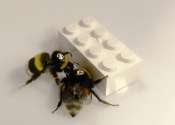Lego-pushing bumblebees reveal insect collaboration dynamics
A new study reveals that cooperation by bumblebees isn't simply a result of accumulated individual efforts. Rather, these miniature-brained creatures are not just hard-working pollinators, but also show signs of being master ...









